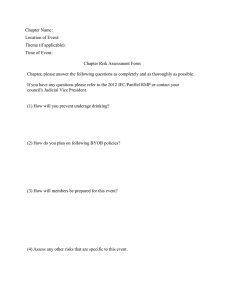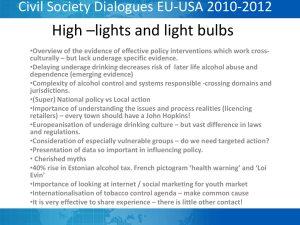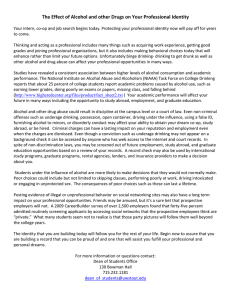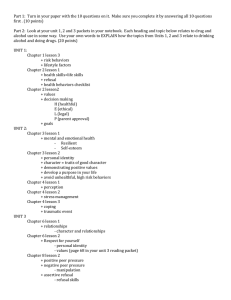Underage Drinking Is a Serious Problem
advertisement
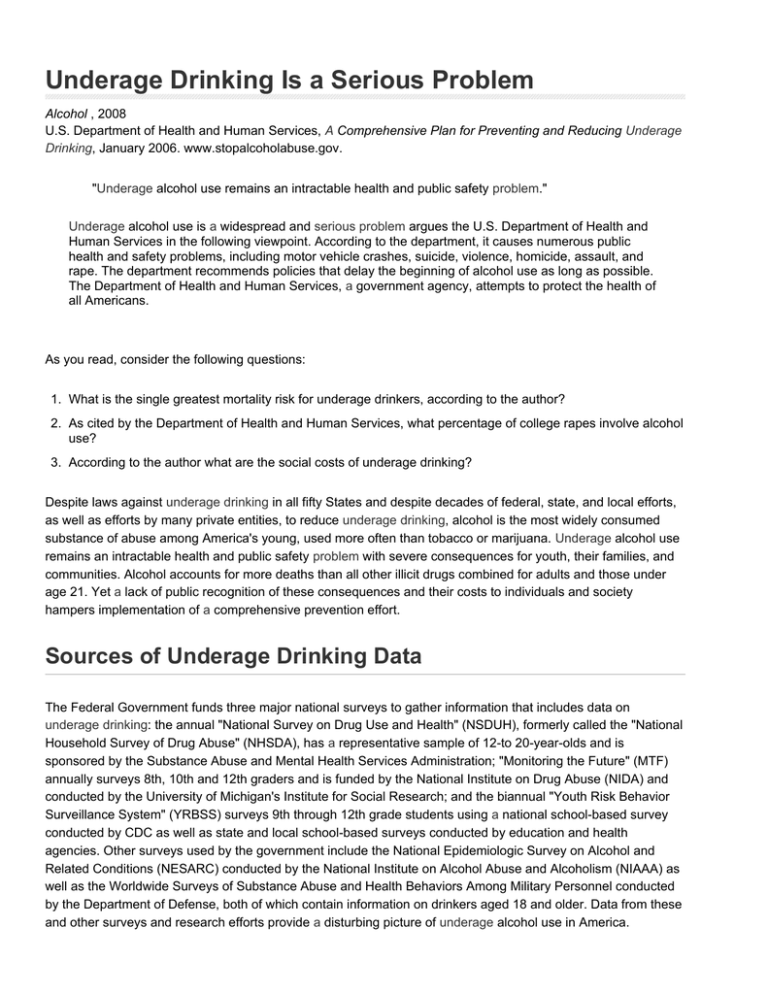
Underage Drinking Is a Serious Problem Alcohol , 2008 U.S. Department of Health and Human Services, A Comprehensive Plan for Preventing and Reducing Underage Drinking, January 2006. www.stopalcoholabuse.gov. "Underage alcohol use remains an intractable health and public safety problem." Underage alcohol use is a widespread and serious problem argues the U.S. Department of Health and Human Services in the following viewpoint. According to the department, it causes numerous public health and safety problems, including motor vehicle crashes, suicide, violence, homicide, assault, and rape. The department recommends policies that delay the beginning of alcohol use as long as possible. The Department of Health and Human Services, a government agency, attempts to protect the health of all Americans. As you read, consider the following questions: 1. What is the single greatest mortality risk for underage drinkers, according to the author? 2. As cited by the Department of Health and Human Services, what percentage of college rapes involve alcohol use? 3. According to the author what are the social costs of underage drinking? Despite laws against underage drinking in all fifty States and despite decades of federal, state, and local efforts, as well as efforts by many private entities, to reduce underage drinking, alcohol is the most widely consumed substance of abuse among America's young, used more often than tobacco or marijuana. Underage alcohol use remains an intractable health and public safety problem with severe consequences for youth, their families, and communities. Alcohol accounts for more deaths than all other illicit drugs combined for adults and those under age 21. Yet a lack of public recognition of these consequences and their costs to individuals and society hampers implementation of a comprehensive prevention effort. Sources of Underage Drinking Data The Federal Government funds three major national surveys to gather information that includes data on underage drinking: the annual "National Survey on Drug Use and Health" (NSDUH), formerly called the "National Household Survey of Drug Abuse" (NHSDA), has a representative sample of 12-to 20-year-olds and is sponsored by the Substance Abuse and Mental Health Services Administration; "Monitoring the Future" (MTF) annually surveys 8th, 10th and 12th graders and is funded by the National Institute on Drug Abuse (NIDA) and conducted by the University of Michigan's Institute for Social Research; and the biannual "Youth Risk Behavior Surveillance System" (YRBSS) surveys 9th through 12th grade students using a national school-based survey conducted by CDC as well as state and local school-based surveys conducted by education and health agencies. Other surveys used by the government include the National Epidemiologic Survey on Alcohol and Related Conditions (NESARC) conducted by the National Institute on Alcohol Abuse and Alcoholism (NIAAA) as well as the Worldwide Surveys of Substance Abuse and Health Behaviors Among Military Personnel conducted by the Department of Defense, both of which contain information on drinkers aged 18 and older. Data from these and other surveys and research efforts provide a disturbing picture of underage alcohol use in America. Some of the principal findings of governmental surveys and other research related to underage alcohol use are described in the following paragraphs. Underage Alcohol Use Is Widespread Underage alcohol use in America is a widespread and serious problem as evidenced by the following data: Current Use: The 2004 NSDUH reported that approximately 29% of Americans aged 12 through 20 (or about 10.8 million minors) reported having at least one drink in the 30 days prior to the survey. Of this age group, 19.6% (or nearly 7.4 million) were binge drinkers, meaning that they had drunk 5 or more drinks on the same occasion (i.e., at the same time or within a couple of hours of each other) on at least 1 day within the past 30 days. Of those in the 12 to 20 age group, 6.3% (or 2.4 million) were heavy drinkers, meaning that they had drunk 5 or more drinks on the same occasion on each of 5 or more days in the past 30 days. All heavy alcohol users are also binge alcohol users. These figures were essentially unchanged from the 2002 and 2003 surveys. Lifetime Use: Data from the 2004 MTF survey of U.S. youth show that 75.1% of 12th graders, 63.2% of 10th graders, and 41.0% of 8th graders have drunk alcohol at some point in their lives. Binge Use: According to data from the 2004 NSDUH, 5.6% of 14-year-olds, 18.3% of 16-year-olds, 33.1% of 18-year-olds, and 40.3% of 20-year-olds had engaged in binge drinking within the past 30 days. Heavy Use: Data from the 2004 NSDUH survey show that 4.5% of 16-year-olds, 11.0% of 18-year-olds, and 16.3% of 20-year-olds had engaged in heavy alcohol consumption within the past 30 days. Use to Intoxication: According to 2005 data from the 2004 MTF survey, 57.5% of 12th graders, 42.1% of 10th graders, and 19.5% of 8th graders reported having been drunk at least once in their lives. Use to Intoxication Within the Last Month: Data from the MTF survey for 2005 indicates that 30.2% of 12th graders, 17.6% of 10th graders, and 6.0% of 8th graders reported having been drunk in the past month. Youth Start Drinking at an Early Age Studies show that drinking often begins at very young ages. Data from recent surveys indicate that approximately: Ten percent of 9-10 year olds have already started drinking Nearly one-third of underage drinkers begin before age 13 The peak years of initiation are 7th through 11th grades, based on data from high school seniors Youths who report drinking prior to the age of 15 are more likely to develop substance abuse problems, to engage in risky sexual behavior, and to experience other negative consequences in comparison to those who begin at a later time. The age of onset of drinking, therefore, is a marker for future problems, including heavier use of alcohol and other drugs during adolescence and the development of an alcohol dependence diagnosis in adulthood. Delaying the age of onset of first alcohol use as long as possible can ameliorate some of the negative consequences associated with underage alcohol consumption. Therefore, whether underage drinkers are starting at younger or older ages over a given period of years is a matter of concern.... Underage drinking is both an individual and societal problem, a matter of public safety and of public health with profound consequences for the young, their families, and their communities. It is a complex problem that has plagued society for generations and results in a range of adverse short- and long-term consequences. Some of these adverse consequences are described in the following paragraphs. In addition to the negatives effects of underage drinking on the drinker, a number of consequences also result to those around him or her, which are referred to as secondary effects. Motor Vehicle Crashes and Other Alcohol-Related Accidents The greatest single mortality risk for underage drinkers is motor vehicle crashes. In 2002, 6,788 persons aged 15 to 20 were involved in fatal crashes and 29% of the drivers in this age group who were killed had been drinking. Relative to adults, young people who drink and drive have an increased risk of alcohol-related crashes because of their relative inexperience behind the wheel and their increased impairment from alcohol. According to survey data, about 5.9% of 16-year-olds, 12.6% of 17-year-olds, 16.4% of 18-year-olds, 21.1% of 19-year-olds, and 23.4% of 20-year-olds reported driving under the influence of alcohol in 2003. The reported prevalence of driving under the influence of alcohol increases with age until 25, after which it declines. Over all, 30.2% of high school students reported that, within the past 30 days, they had ridden with a driver who had been drinking. For seniors, that figure rose to 33.3%. In 2002, 2,569 individuals ages 16 to 20 died from unintentional injuries other than motor vehicle crashes, such as poisonings, drownings, falls, burns, etc. Research suggests that approximately 40% of these deaths were alcohol-related. Violence, Suicide, and Alcohol In 2002, 2,732 young people ages 12 to 20 died from homicide and 2,196 from suicide. At present, we do not know exactly how many of these deaths are alcohol related. One study estimated that for all ages combined nearly half of the homicides and almost a third of the suicides were alcohol-related. Another study of deaths among those under 21 reported that over a third of the homicides were alcohol-related as were 12% of male suicides and 8% of female suicides. Individuals under the age of 21 commit 45% of rapes, 44% of robberies, and 37% of other assaults. It is estimated that for the population as a whole, 50% of violent crime is related to alcohol use. The degree to which violent crime committed by those under 21 is alcohol-related remains to be determined. It is estimated that 90% of college rapes involve the use of alcohol by the assailant, the victim, or both. About 97,000 college students are victims of sexual assault or date rape related to alcohol use each year. Alcohol use is involved in 95% of all violent crime on college campuses. More than 600,000 college students are assaulted by another student who has been drinking, and another 500,000 students were unintentionally injured while under the influence of alcohol. Other Risky Behaviors A variety of other risky behaviors are associated with underage alcohol use. Some of these behaviors include riding with a driver who has been drinking, unplanned and unprotected sexual activity, and carrying a weapon to school. Although the data indicate that alcohol use is correlated with these risky behaviors, the data cannot prove causation between alcohol use and the behavior. Nevertheless, it is known that alcohol can impair an individual's decision-making capacity and that it reduces inhibitions. Therefore, drinking may be related to the decision to engage in risky behavior, particularly in adolescents whose judgment and decision-making capabilities are still developing. Potential Brain Impairment Brain impairment is one of the potential long-term risks of underage alcohol consumption. Neurobiological research suggests that adolescence may be a period of unique vulnerability to the effects of alcohol. For example, early heavy alcohol use may have negative effects on the actual physical development of the brain structure of adolescents as well as on brain functioning. Negative effects indicated by neurological studies include decreased ability in planning, executive functioning, memory, spatial operations, and attention, all of which play an important role in academic performance and future levels of functioning. Increased Risk of Developing an Alcohol Use Disorder The early onset of alcohol use (at age 14 or younger) in combination with an escalation of drinking in adolescence have both been documented in a number of studies as risk factors for the development of alcohol-related problems in adulthood. The onset of alcohol consumption in childhood or early adolescence is a marker for later alcohol-related problems, including heavier adolescent use of alcohol and other drugs and the development of alcohol abuse or dependence in adulthood. Persons aged 21 or older who reported first use of alcohol before age 14 were more than 6 times as likely to report past year alcohol dependence or abuse than persons who first used alcohol at age 21 or older. Other Negative Consequences of Underage Drinking Other consequences of underage drinking include death from alcohol poisoning, academic problems, various social problems, and physical problems such as medical illnesses. The social costs of underage drinking are conservatively estimated at $53 billion, including $19 billion from traffic crashes and $29 billion from violent crime. The social, individual, and economic consequences of underage drinking make it a leading health problem in the United States, one that has remained stubbornly resistant to a variety of measures initiated to prevent and reduce it over the past three decades. Because adult alcohol use is an accepted part of American life, underage drinking must be addressed within that context. The primary preventive issue in underage drinking is to delay onset of alcohol use as long as possible—preferably until the age of 21. Yet that delay must be achieved within an environment in which alcohol is readily available to most underage youth and is attractive to them. A comprehensive plan involving federal, state, and local governments; organizations and institutions in the private sector; concerned individuals; and the parents of underage youth is critical if progress is to be made against this intractable health problem. Further Readings Books Anatoly Antoshechkin Alcohol: Poison or Medicine? Bloomington, IN: 1st Books Library, 2002. Thomas Babor Alcohol: No Ordinary Commodity. New York: Oxford University Press, 2003. Andrew Barr Drink: A Social History of America. New York: Carroll and Graf, 1999. Richard J. Bonnie and Mary Ellen O'Connell, eds. Reducing Underage Drinking: A Collective Responsibility. Washington, DC: National Academies, 2004. Nick Brownlee This Is Alcohol. London: Sanctuary, 2002. Griffith Edwards Alcohol: The World's Favorite Drug. New York: Thomas Dunne Books, 2002. Kathleen Whelan Fitzgerald Alcoholism: The Genetic Inheritance. Friday Harbor, WA: Whales Tales Press, 2002. Gene Ford The Science of Healthy Drinking. San Francisco: Wine Appreciation Guild, 2003. Marc Galanter, ed. Alcohol Problems in Adolescents and Young Adults: Epidemiology, Prevention, and Treatment. New York: Springer, 2006. Janet Lynne Golden Message in a Bottle: The Making of Fetal Alcohol Syndrome. Cambridge, MA: Harvard University Press, 2005. Marcus Grant and Joyce O'Connor, eds. Corporate Responsibility and Alcohol: The Need and Potential for Partnership. New York: Routledge, 2005. William Grimes Straight Up or On the Rocks: The Story of the American Cocktail. New York: North Point, 2001. Mack P. Holt Alcohol: A Social and Cultural History. New York: Berg, 2006. Linda Costigan Lederman Changing the Culture of College Drinking: A Socially Situated Health Communication Campaign. Creskill, NJ: Hampton, 2005. Jared C. Lobdell This Strange Illness: Alcoholism and Bill W. New York: Aldine de Gruyter, 2004. Sara Markowitz, Robert Kaestner, and Michael Grossman An Investigation of the Effects of Alcohol Consumption and Alcohol Policies on Youth Risky Sexual Behaviors. Cambridge, MA: National Bureau of Economic Research, 2005. Marjana Martinic and Barbara Leigh Reasonable Risk: Alcohol in Perspective. New York: Brunner-Routledge, 2004. Richard Muller and Harald Klingemann From Science to Action?: 100 Alcohol Policies Revisited. Norwell, MA: Kluwer Academic, 2004. Thomas Nordegren The A-Z Encyclopedia of Alcohol and Drug Abuse. Parkland, FL: Brown Walker, 2002. Office of National Drug Control Policy The Challenge in Higher Education: Confronting and Reducing Substance Abuse on Campus. Washington, DC: Office of National Drug Control Policy, 2004. Nancy Olson With a Lot of Help from Our Friends: The Politics of Alcoholism. New York: Writers Club, 2003. C.K. Robertson, ed. Religion & Alcohol: Sobering Thoughts. New York: Peter Lang, 2004. Frederick Rotgers et al. Responsible Drinking: A Moderation Management Approach for Problem Drinkers. Oakland, CA: New Harbinger, 2002. Sarah W. Tracy Alcoholism in America: From Reconstruction to Prohibition. Baltimore, MD: Johns Hopkins University Press, 2005. Sarah W. Tracy and Caroline Jean Acker Altering American Consciousness: The History of Alcohol and Drug Use in the United States, 1800-2000. Amherst, MA: University of Massachusetts Press, 2004. Chris Volkman and Toren Volkman et al. From Binge to Blackout: A Mother and Son Struggle with Teen Drinking. New York: New American Library, 2006. Scott T. Walters and John S. Baer Talking with College Students about Alcohol: Motivational Strategies for Reducing Abuse. New York: Guilford, 2006. Thomas M. Wilson, ed. Drinking Cultures: Alcohol and Identity. New York: Berg, 2005. Koren Zailckas Smashed: Story of a Drunken Girlhood. New York: Viking, 2005. Periodicals David Gargill and Howie Kahn "Drink: Raise Your Spirits," GQ, December 2006. Christine Gorman "What Alcohol Does to a Child," Time, June 5, 2006. Diana Kohnle "Alcohol: A Bigger Threat to U.S. Youth than Drugs," HealthDay, June 29, 2006. Alexis Kwiatkowski "Drinking Alcohol Just Adds Problems," Post-Standard, March 20, 2007. Ted R. Miller, David T. Levy, Rebecca S. Spicer, et al. "Societal Costs of Underage Drinking," Journal of Studies on Alcohol, July 2006. Clayton Neighbors, Casey J. Spieker, Laura Oster-Aaland, et al. "Celebration Intoxication," Journal of American College Health, September 2005. Heather Ogilvie "A Different Approach to Treating Alcoholism," Consumers' Research Magazine, June 2002. Richard Rice "College Drinking: Norms vs. Perceptions," Scientist, February 2006. Susan Schindehette "Dying for a Drink," People Weekly, September 4, 2006. Shane Watson "Drink: Self-Medicating with Alcohol Is a Natural Response to the Human Condition," New Statesman, May 8, 2006. "Where They Drink, When They Drink, and How They Conceal It—Teens Talk to Us About Their World of Alcohol," Columbus Ledger-Enquirer October 24, 2006. Full Text: COPYRIGHT 2008 Gale, Cengage Learning. Source Citation: "Underage Drinking Is a Serious Problem" by U.S. Department of Health and Human Services. Alcohol. Andrea C. Nakaya, Ed. Opposing Viewpoints® Series. Greenhaven Press, 2008. U.S. Department of Health and Human Services, A Comprehensive Plan for Preventing and Reducing Underage Drinking, January 2006. www.stopalcoholabuse.gov. Document URL http://ic.galegroup.com.ezproxy.auckland.ac.nz/ic/ovic/ViewpointsDetailsPage/Vie wpointsDetailsWindow?displayGroupName=Viewpoints&disableHighlighting=false&a mp;prodId=OVIC&action=e&windowstate=normal&catId=&documentId=GAL E%7CEJ3010217275&mode=view&userGroupName=learn&jsid=2eadf459d4173305 41245e3361e827da Gale Document Number: GALE|EJ3010217275
